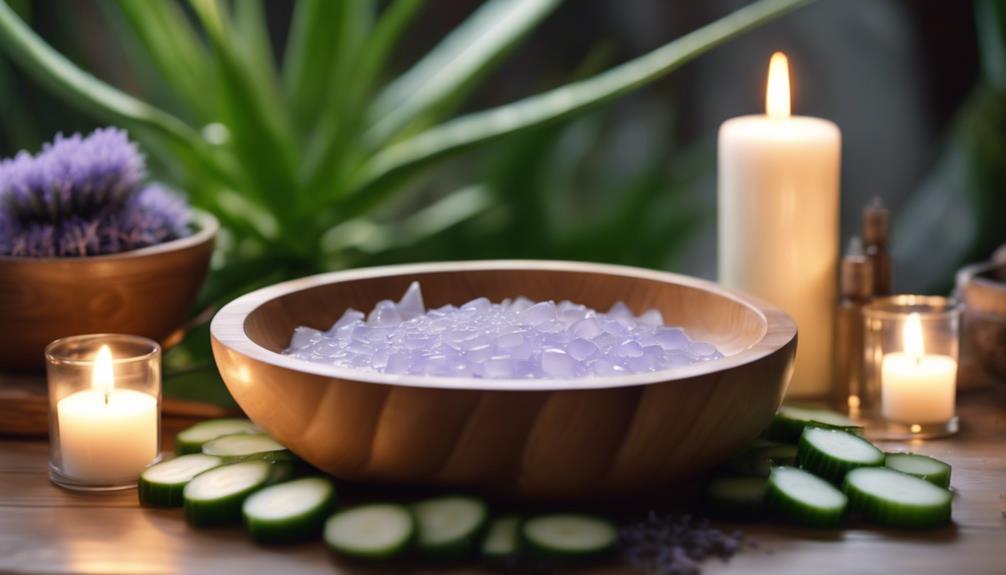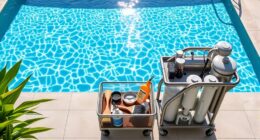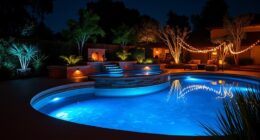To refresh your tanning bed, begin by checking for any scratches or cracks on the acrylic surface. Make sure you have the necessary cleaning supplies on hand, such as distilled water and white vinegar, for proper disinfection. Use gentle microfiber cloths to wipe down the bed, avoiding harsh chemicals that could harm the acrylic. Consider using hospital-grade disinfectants and always follow the manufacturer’s guidelines. Once you have finished cleaning, inspect all frequently touched areas for any leftover residue or damage. Consistent upkeep will prolong the life of your tanning bed and ensure a safe environment for your clients. Looking for more tips to maintain your tanning bed in peak condition?
Key Takeaways
- Inspect high-touch areas for scratches or cracks to ensure safety and maintain the tanning bed's aesthetic quality.
- Use a gentle cleaning solution of distilled water and vinegar to effectively disinfect and remove odors without damaging acrylic surfaces.
- Opt for hospital-grade disinfectants that are non-alcoholic and non-ammonia-based to protect the integrity of your tanning bed.
- Schedule regular professional cleanings to ensure thorough sanitization and extend the lifespan of your equipment.
Tanning Bed Assessment
Regularly evaluating your tanning bed for wear and damage is essential to guarantee safe and effective use. Start by inspecting high-touch areas, looking for scratches or cracks on the acrylic surfaces.
Check the timer, fans, and circuit boards to confirm everything's functioning properly. If you notice any unusual smells or issues, address them promptly to prevent further complications.
Regular maintenance helps avoid mid-tan equipment failures that can disrupt your session. Schedule a professional deep cleaning as needed, and always wipe down surfaces and high-touch points after each use.
This practice not only maintains hygiene but also extends the life of your tanning bed. Remember, a well-maintained tanning bed enhances the experience for you and your clients.
Cleaning Preparation Techniques
Before you start cleaning your tanning bed, gather all necessary supplies and create an effective cleaning solution to guarantee a thorough sanitization. Here's a quick list to help you prepare:
| Supplies | Purpose | Tips |
|---|---|---|
| Distilled Water | Base for cleaning solution | Use for gentle cleaning |
| White Vinegar | Disinfectant | Mix for strong odor removal |
| Essential Oils | Natural fragrance | Choose your favorite scent |
| Microfiber Cloth | Dusting and wiping | Use fresh cloths for best results |
| Spray Bottle | Application of solution | Label for easy identification |
Start by dusting the bed with a microfiber cloth, then spray your cleaning solution generously over the surfaces. Focus on high-touch areas and let the solution sit for the recommended time before wiping down everything with a clean, damp cloth.
Disinfectant Selection

Selecting the right disinfectant is essential for effectively sanitizing your tanning bed and ensuring the safety of your clients. You'll want to choose products that aren't only effective but also safe for the materials of your bed.
Here are three key factors to evaluate:
- Hospital-grade disinfectants: These are proven to eliminate germs effectively, providing peace of mind.
- Non-alcoholic and non-ammonia-based: These options protect your acrylic surfaces from damage while still offering powerful cleaning.
- Quick contact time: Look for disinfectants that work quickly to maximize efficiency during busy times.
Always follow manufacturer instructions for use and safety precautions, ensuring a safe environment for both you and your clients.
Acrylic Shield Maintenance
Maintaining your acrylic shield is essential for guaranteeing both the longevity of the tanning bed and the safety of its users.
Start by using soft cloths and natural cleaners specifically designed for acrylic surfaces. Avoid abrasive materials or harsh chemicals, as they can scratch and damage the shield.
Always use fresh cloths to prevent residue buildup and regularly launder them for peak cleanliness.
After each cleaning, inspect the acrylic for any scratches or cracks that could compromise its integrity.
Ascertain the surface is completely dry before the next use to prevent any slipping hazards.
Post-Cleaning Inspection

After cleaning the acrylic shield, it's important to conduct a thorough inspection to confirm no dirt or grime has been missed. This step guarantees your tanning bed remains hygienic and safe for clients.
Here are three key areas to focus on:
- High-Touch Points: Check handles, knobs, and any areas frequently contacted during use for remaining residue or smudges.
- Acrylic Surface: Inspect the entire shield for scratches or cracks that could compromise cleanliness and safety.
- Nooks and Crannies: Don't overlook hard-to-reach spots. Use a damp cloth to confirm all surfaces are disinfected.
Completing this inspection will help you maintain a pristine tanning environment for all users.
Effective Cleaning Solutions
To achieve ideal hygiene for your tanning bed, use a homemade cleaning solution that combines distilled water, vinegar, and essential oils. This combination effectively disinfects while being gentle on the acrylic surfaces.
Start by mixing one part vinegar with three parts distilled water in a spray bottle. Add a few drops of your favorite essential oil for a pleasant scent. Shake well before each use to activate the ingredients.
Dust the tanning bed with a microfiber cloth first, then spray the solution generously on the surfaces, focusing on high-touch areas. Allow the disinfectant to sit for the recommended time before wiping down with a clean, damp cloth.
This guarantees thorough sanitization, keeping your tanning bed fresh and inviting for every session.
What to Avoid

Avoid using abrasive cleaners and tools, as they can scratch and damage your tanning bed's acrylic surfaces. Protect your investment by steering clear of harsh chemicals that can compromise the integrity of your equipment. Always prioritize gentle cleaning methods to maintain the quality of your tanning bed.
Here are three things to avoid:
- Abrasive Cleaners: Products with grit can leave permanent scratches.
- Ammonia-Based Solutions: These can cause discoloration and weaken acrylic.
- Magic Erasers: These may seem effective but can harm the surface.
Professional Cleaning Services
While gentle cleaning methods are important, sometimes it's best to enlist professional cleaning services for a thorough and safe sanitization of your tanning bed.
Professionals have the right equipment and expertise to guarantee your bed is deep-cleaned without causing damage. They use specialized products designed to protect acrylic surfaces while eliminating harmful germs.
This can be especially beneficial if you're unsure about your cleaning technique or want to save time. Plus, regular professional cleanings can extend the life of your tanning bed, ensuring it remains in prime condition for your clients.
Frequently Asked Questions
How Often Should I Clean My Tanning Bed?
You should clean your tanning bed after every use to maintain hygiene. Additionally, perform a deep clean weekly to guarantee peak performance and longevity, addressing any wear or damage during your routine inspections.
Can I Use Essential Oils in the Cleaning Solution?
Absolutely, you can use essential oils in your cleaning solution. Just mix them with distilled water and vinegar. It'll not only clean effectively but also leave your tanning bed smelling fresh, like a breath of spring.
Is It Safe to Use a Vacuum on My Tanning Bed?
Using a vacuum on your tanning bed isn't recommended. It can damage the acrylic surfaces and other components. Instead, opt for a microfiber cloth to safely clean dust and debris without causing harm.
What Should I Do if I Notice a Crack in the Acrylic?
If you notice a crack in the acrylic, stop using the tanning bed immediately. Inspect the damage closely, and consider contacting a professional for repairs to guarantee safety and prevent further issues during tanning sessions.
How Can I Maintain My Tanning Bed's Lifespan?
You might think tanning beds last forever, but regular maintenance is key to longevity. Inspect for damage, clean after every use, and schedule deep cleanings to keep your tanning bed in top shape for years.
What are the best cleaning tips for tanning beds to ensure they are properly sanitized?
When sanitizing tanning beds for health, always start by vacuuming loose debris, then wipe down all surfaces with a disinfectant solution. Be sure to clean the acrylic and lamps to prevent bacteria growth. Don’t forget to replace the protective goggles and sanitize the floors to maintain a clean environment.
What are the Benefits of Using Eco-Friendly Cleaning Products for Revitalizing Tanning Beds?
Revitalizing tanning beds with ecofriendly tanning bed cleaners can improve the indoor tanning experience. These products are safer for both the environment and tanners, as they contain natural, non-toxic ingredients that effectively clean and maintain the beds. Using eco-friendly cleaners can also prolong the lifespan of tanning equipment.
What Eco-Friendly Cleaning Products Can I Use to Revitalize My Tanning Bed?
When revitalizing your tanning bed, it’s important to use ecofriendly tanning bed cleaning essentials to maintain a healthy environment. Look for cleaning products that are non-toxic, biodegradable, and free from harmful chemicals. Products made from natural ingredients like vinegar, baking soda, and essential oils are great options to consider.
What Eco-Friendly Cleaning Products Can I Use to Revitalize My Tanning Bed?
Looking to maintain an ecofriendly tanning bed cleaning routine? Try using environmentally-friendly products like vinegar, baking soda, and citrus-based cleaners. These ecofriendly tanning bed cleaning essentials can help remove dirt, oil, and sweat without harming the environment or your tanning bed’s surfaces.
Conclusion
By following these essential cleaning tips, you'll transform your tanning bed into a sanctuary of sun-kissed perfection.
Think of it as nurturing a garden; with regular care and attention, it'll flourish and provide a radiant glow for you and your clients.
Remember, a clean tanning bed not only enhances your experience but also guarantees safety.
So, roll up your sleeves and plunge into this routine—your tanning bed deserves it, and so do you!









